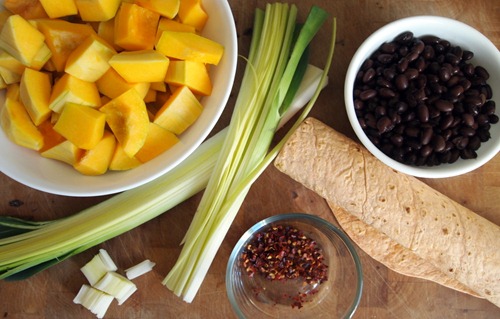Oct
Butternut Squash & Black Bean Enchiladas
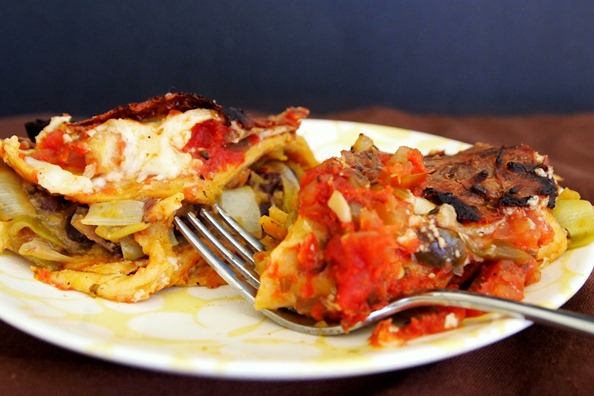
I love butternut squash. Actually, I love all squashes. It is my humble opinion that winter squash are one of the most versatile, delicious, and easy to prepare vegetables. They are also super simple to grow and come in an amazing array of funky shapes and colors. In fact, I am such a dork about squash that I’ve gathered some some fun tidbits about this special vegetable, um…fruit, for your reading enjoyment.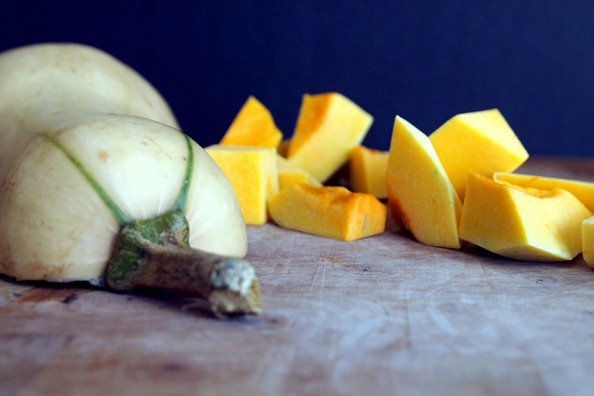
 Squash are one of the oldest cultivated crops in the Western hemisphere. They were first gathered and consumed in the area between Mexico and Guatemala around 8000 B.C. Apparently back then only the seeds were eaten though, because the early varieties were bitter and didn’t contain much flesh.
Squash are one of the oldest cultivated crops in the Western hemisphere. They were first gathered and consumed in the area between Mexico and Guatemala around 8000 B.C. Apparently back then only the seeds were eaten though, because the early varieties were bitter and didn’t contain much flesh.
The butternut squash is the new kid on the block having only made its appearance in 1944.
We commonly refer to squash as a vegetable, but it is actually considered a fruit. Like cucumbers and melons they are part of the Cucurita genus.
This stuff is good for you!!! Winter squash is a fantastic source of antioxidants, including Beta Carotene and Alfa Carotene. It is also full of vitamin C (about 1/3 of daily value in a every cup), has anti-inflammatory properties, and contains omega 3 fatty acids. 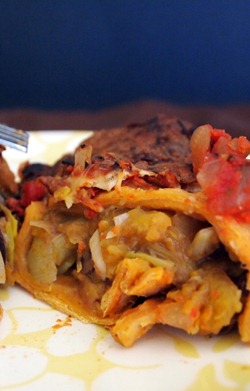
This fall I am setting out on a journey of squash exploration (and I hope you’ll come with me). I plan to hone my squash taming skills with some of the lesser know varieties like Carnival and Gold Nugget. I also will get rough with the beastly Hubbard squash (they say the best way to open this monster is to throw it on the floor). This week though, I thought I would start off slow with one of the most common of the winter squashes, the butternut. The butternut squash has a beautiful pale yellow skin and is shaped like a vase or a bell. Inside the deep-orange flesh has a sweet, nutty flavor and when mashed or pureed turns into a silky consistency that makes an excellent soup. Butternut squash can also be roasted, baked or boiled. In this recipe it is slowly simmered in a combination of cider vinegar and soy sauce which results in a mind-blowing tangy yet sweet flavor. The squash is then partially mashed and combined with leeks, black beans and cheese- yumm! This is a simple dish with a bold flavor that is sure to please.
| Serves 6 Ingredients: 6 large whole wheat tortillas 5 cups butternut squash, peeled and cubed ¼ cup soy sauce, low sodium 1/2 cup cider vinegar 1/2 cup water 1 tablespoon olive oil 2 leeks, thinly sliced 4 cloves garlic, chopped 1 teaspoon ground cumin ½ teaspoon crushed red pepper 1 15 ounce can low sodium black beans, drained and rinsed 2 cups cheddar cheese, grated 1 cup salsa (Green Mountain Gringo is my favorite brand. It has a fresh flavor and texture that is as close to homemade as you can get in a jar. ) Optional: ½ -1 cup sour cream 1-2 tablespoons fresh cilantro 1 cup salsa |
|
Oct
Healthy Apple Banana Muffins
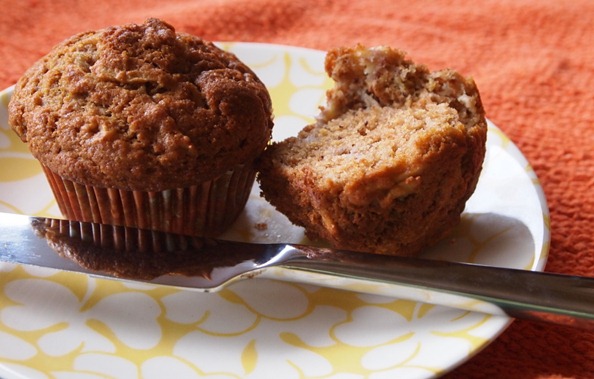
Its October and autumn has officially arrived. Around here that means hillsides dotted with deep gold and brilliant red foliage, eager tourists crowding the roads, restaurants, and hiking trails, pumpkin and harvest festivals in every town, fresh apple cider and cider donuts, farm stands stocked with mounds of squash in every variety, shape and color…I could go on and on. This is New England after all and we do love the autumnal time of year.While I profess to enjoy all the things autumn has to offer, by far my favorite thing about this time of year is cooking and baking. 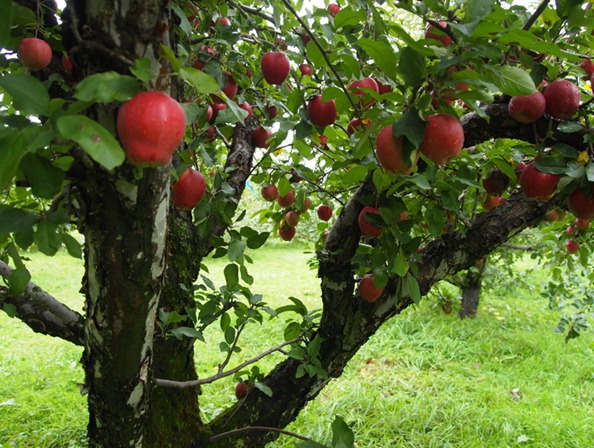
Don’t get me wrong, I love both these activities at any time of the year, but there is something special about cooking in the fall that I can’t quite put my finger on. Maybe it’s the smell of freshly baked apple pie wafting throughout the house, or the comfort of making butternut squash mac and cheese on a dark and dreary October afternoon. Perhaps its because for me fall signals a general slow down of life; a time when I do far less digging in the garden and far more creating in the kitchen. One thing I am sure of is that my love of autumn cooking is inspired in huge part by the seasonal produce that is abundant this time of year. Fall greens and root vegetables, garlic, squash, pumpkins, and pears, I love them all. But in my opinion it is the apple, with its bright red skin and crisp yet juicy inside that is the king of fall produce. 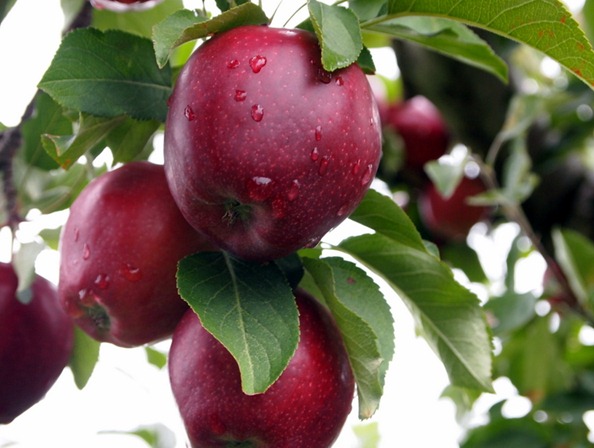
Malus Pumila, better known as the common apple is possibly the most widely grown and consumed fruit in the world. There are thousands of varieties boosting different sizes, colors, and flavors. The humble apple is the inspiration for countless dishes that are savory, sweet, spicy, and everything in between. In addition to its beautiful shape and subtle yet sweet flavor, it is the versatility of the apple that draws me to it the most. The ease with which it is inserts itself into a spicy curry stew, melds perfectly into a balsamic glaze over roast pork, or pairs seamlessly with cinnamon and pie crust is at the same time inspiring and overwhelming. Faced with an overflowing tote of recently picked apple I am almost at a loss as to what to create first. Almost. Luckily I quickly recover my senses and decide to start with a basic muffin.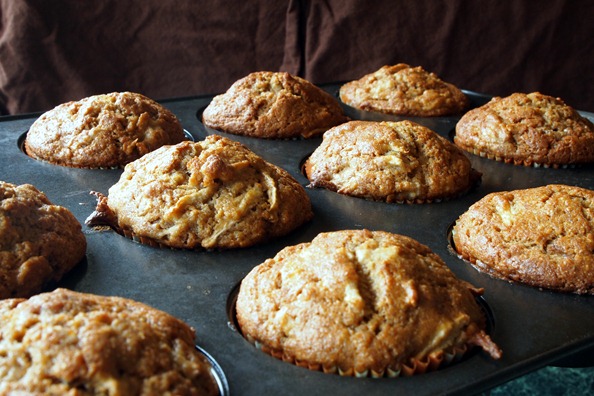
I make muffins at all times of the year using countless combinations of ingredients and because of my love for muffins I have been on the quest to create a healthy muffin that I can consume everyday without guilt. I used to be of the opinion that the best muffins are the huge ones you find in the local bakery. You know the kind I am talking about. Big enough that you could share if you really wanted to, decadently moist inside with a crispy,crumbly topping that spills over the edge. This is my kind of muffin. Unfortunately, eating these muffins is simply not a sustainable practice. I recently read somewhere that many muffins contain more sugar that most cakes, and as much fat as some fast food breakfast items- yikes! 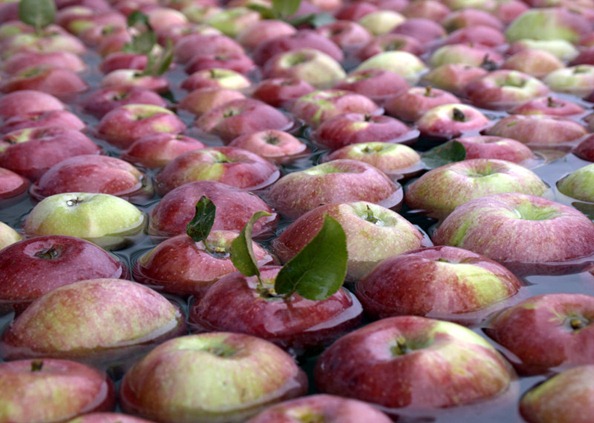 There has to be a better way. A way to have your muffin and eat it to. Over the past few weeks I have been working on a healthy version of the muffin. One that is not loaded with butter and sugar, yet still retains that moist texture and sweet muffiny flavor that I crave. I went through many versions of this muffin. I experimented with plain yogurt, apple sauce, small amounts of canola oil, honey as a sugar substitute and other countless failed attempts. Finally I came to the conclusion that the key to moist, yet healthy, muffin is the addition of a banana mixed with milk, a small(er) amount of butter, and a combo of several flours and wheat germ. I will not proclaim that this is a true rival for the legendary bakery muffin, but it comes close. It is a sensible size, lacks a sugary topping and doesn’t have that extra soft texture that can only come from pure white flour. However, this recipe contains almost half the amount of butter than a traditional muffin, at least a 1/4 cup less sugar, and a whole lot less guilt. Muffins lovers rejoice! Now you really can have your muffin and eat it too.
There has to be a better way. A way to have your muffin and eat it to. Over the past few weeks I have been working on a healthy version of the muffin. One that is not loaded with butter and sugar, yet still retains that moist texture and sweet muffiny flavor that I crave. I went through many versions of this muffin. I experimented with plain yogurt, apple sauce, small amounts of canola oil, honey as a sugar substitute and other countless failed attempts. Finally I came to the conclusion that the key to moist, yet healthy, muffin is the addition of a banana mixed with milk, a small(er) amount of butter, and a combo of several flours and wheat germ. I will not proclaim that this is a true rival for the legendary bakery muffin, but it comes close. It is a sensible size, lacks a sugary topping and doesn’t have that extra soft texture that can only come from pure white flour. However, this recipe contains almost half the amount of butter than a traditional muffin, at least a 1/4 cup less sugar, and a whole lot less guilt. Muffins lovers rejoice! Now you really can have your muffin and eat it too. 
| Makes 12 muffins Ingredients: 1 cup whole-wheat flour ¾ cup white flour ¼ cup wheat germ 1 teaspoons baking powder 1 ½ teaspoons cinnamon ¼ teaspoon nutmeg ½ teaspoon salt ½ cup (1 stick unsalted butter) 1/2 cup packed light brown sugar 2 eggs 2 ripe bananas 1/3 cup 2% milk 2 apples, grated |
|

